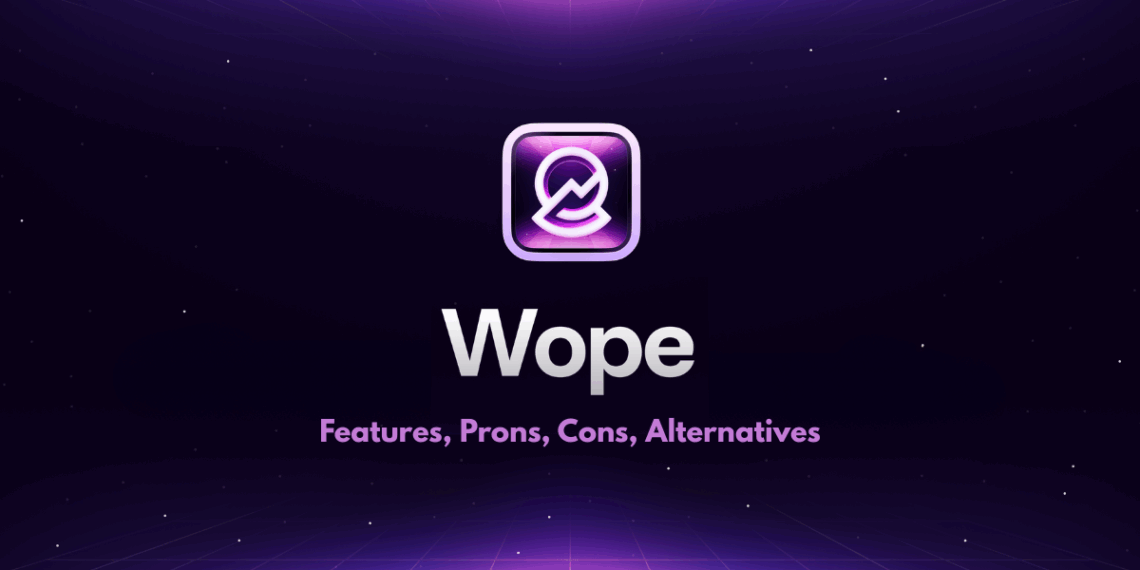In a world where ranking on Google can make or break your startup, SEO platforms are crucial. Founders often turn to tools like Ahrefs, SEMrush, or SE Ranking to get an edge. Then came Wope — an AI-powered SEO tool that promised advanced insights with a user-friendly experience.
🚨But in 2025, something changed. Wope experienced a significant operational breakdown, raising serious red flags. This article takes a deep dive into Wope’s features, pricing, startup program, and the reliability risks every founder must consider.
Wope Overview
Launched in 2019, Wope entered the SEO space as a bold contender aiming to democratize search engine optimization through AI 🧠. Its core ambition was to serve as a virtual SEO consultant—an intelligent assistant that could automate rank tracking, uncover keyword opportunities, and streamline content strategy using cutting-edge machine learning🚀. The platform emphasized accessibility, marketing itself heavily to startups, agencies, and content teams 📊, and standing out with its familiar spreadsheet-like interface that reduced friction for non-technical users.
Wope’s approach included features like AI content generation 🤖, smart keyword grouping, and visual SERP metrics—all framed to help lean teams compete with larger players. Early adopters praised its balance of innovation and ease-of-use. However, this promise was critically undermined in early 2025 when the platform suffered prolonged service outages ⚠️ and a collapse in customer support 📪, leaving many users in the dark. For startups relying on consistent SEO insights to fuel growth 💼, this breakdown raised serious concerns about Wope’s long-term reliability and operational stability.
Wope Key Features
Wope was designed to give startups and digital teams a powerful edge in SEO without the typical complexity. Here’s a closer look at the standout tools and technologies it brought to the table before its service issues began:
🔢 Rank Tracker & Smart Indicators
Tracks keyword rankings across mobile and desktop with unique visual metrics like Pixel Rank, Visual Rank, and Visibility Score. Offers alerts for seasonality trends, cannibalization, and mobile discrepancies.
📈 Keyword & Competitor Research (Beta)
Helps discover keyword opportunities and analyze rivals. Features include Smart Competitor Finder, Keyword Overlap, and Backlink Reports – though some remain in Beta.
🤞 AI Content Assistant (Beta)
Assists with content briefs, outlines, and writing suggestions using an AI editor and tone-adjustment tools. Limited by word credits and currently in testing.
📃 Spreadsheet-Like Interface
A familiar Excel-style layout allows filtering, tagging, and summarizing data without export. Useful for founders wearing multiple hats.
⚙️ Technical SEO Tools
Provides Page Speed insights, Snippet Optimization, and SERP Feature tracking to improve performance on Google.
📊 Tagging & Organization
Automated and manual keyword tagging using semantic similarity or user-defined logic. Nested tags supported for complex campaigns.
🔗 Google Search Console Integration
Wope supports native integration with GSC. More integrations (Google Analytics, Looker Studio) are on the roadmap but delayed.
🔄 Project Setup & Management
Create and manage projects in under a minute. Limited to 5 projects on the Starter plan.

Pros and Cons of Wope for Startups
👍 Pros
- AI automates time-consuming SEO tasks
- Clean UI with spreadsheet-style interface
- Strong tagging and keyword grouping options
- Unique visual ranking metrics
- Significant startup discounts available
👎 Cons
- Platform outages and non-functionality in 2025
- Unresponsive customer support during crisis
- Beta features may lack stability
- Delayed or missing integrations
- Learning curve for AI-assisted workflows
Considering Wope for Startups
Before choosing Wope, it’s essential for founders to reflect on how well the tool aligns with their growth goals, team skills, and infrastructure needs. Use these quick questions to assess the risks and potential fit for your startup:
📌 Is SEO a core growth strategy for you? If your startup relies heavily on organic traffic for lead generation or brand discovery, a platform like Wope—if stable—could be central to your strategy. Otherwise, it may add unnecessary complexity.
💰 Budget-conscious? Wope offers deep startup discounts, making it attractive for lean teams. But remember: savings don’t matter if the tool isn’t usable. Factor in the risk of outages before committing.
🔗 Do you need integrations? If seamless data flow between tools like Google Analytics, Looker Studio, or Slack is critical to your workflow, Wope may fall short for now. Many integrations are delayed or roadmap-only.
👥 Small team with limited SEO knowledge? Wope’s intuitive UI and AI features were designed to support non-experts. However, during outages, a lack of responsive support can leave less technical users stranded.
📈 Need scalability? Wope’s higher-tier plans promise generous keyword limits, advanced reporting, and project capacity. But those benefits hinge on platform stability—otherwise, scalability turns into frustration.

Wope Plans and Pricing
Wope offers tiered pricing. The Starter Plan is marketed to startups.
| Plan | Monthly Price | Key Features |
|---|---|---|
| Starter | $47/mo ($39.17 annually) | 500 keywords, 10k AI words, 250 reports, 5 projects, 2 users |
| Pro | $89/mo | 2k keywords, 25k AI words, 500 reports, 15 projects, 5 users |
| Growth | $199/mo | 5k keywords, 100k AI words, 1k reports, 50 projects, 10 users |
| Elite | $399/mo | Unlimited keywords/reports, API access, priority support |
Wope Startup Discount Info
Wope offered up to 80% off in year 1 🎁and 50% in year 2🎁 for eligible startups (under 3 years old, <10 employees, <$2M funding). These offers came via platforms like XRaise, but the practical value is limited if the platform is not operational.
Comparing Wope with Alternatives
| Feature | Wope | SEMrush | Ahrefs |
|---|---|---|---|
| Free tier🆓 | No | Limited | No |
| Rank tracking depth🏅 | Visual + Pixel | Standard | Standard |
| AI content tools🤖 | Yes (Beta) | No | No |
| Technical SEO features💕 | Yes | Yes | Yes |
| Customer support👩💻 | Unresponsive (2025) | Responsive | Responsive |
| Price (starting)💵 | $39.17/mo | $129.95/mo | $99/mo |

FAQs
❓ Is Wope easy for non-technical users?
Yes, but only if the platform is working. The spreadsheet UI is intuitive for most.
❓ Are there surprise costs or upgrade traps?
The pricing tiers are transparent, but plan limits (e.g., tracked keywords) may require upgrades.
❓ Can it integrate with our stack?
Limited integrations currently. Google Search Console is supported. Others are delayed.
❓ Is the platform stable right now?
As of mid-2025, no. Reports indicate widespread outages and support collapse.
❓ Does the startup discount still apply?
Possibly, but verify current availability. The value depends on platform recovery.
❓ How does it compare with SEMrush or Ahrefs?
Wope is cheaper and more AI-driven, but far less reliable.
Final Thoughts
Wope once held great promise: AI-powered SEO insights 🚀, affordable pricing 💸, and a clean UI designed for scrappy teams 🧑💻. For startups hungry for visibility and strapped for time ⏳, that pitch was powerful. The platform’s early innovations, such as visual rank metrics 📊 and AI content suggestions 🤖, generated significant buzz—particularly among early adopters who praised its speed, usability, and intelligence-driven workflows.
However, the collapse in functionality and support in 2025 renders all those strengths moot ⚠️. Multiple user reports highlighted prolonged outages 🛑, lack of data updates 🔄, and a total absence of customer service 📭 during critical periods. These issues weren’t just minor glitches—they directly undercut the core value Wope was meant to deliver.
💡Until Wope shows signs of a full, sustained recovery with transparent communication and consistent performance across its key modules, we strongly advise against relying on it. Founders must prioritize operational dependability over theoretical features—especially when marketing and growth depend on timely, accurate SEO data 📈.
For now, startups should stick with trusted SEO platforms that offer both innovation and reliability 🧱. The risks of adopting a tool still recovering from a public breakdown far outweigh the potential benefits of experimental features 🎲.










